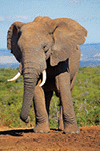


We often fail to realize how much it takes to maintain all the things that have allowed the earth to exist and to support life for a very long time. There have always been plants that grew prolifically and there had to be gardeners to prune the plants and prevent them from crowding out other life forms. There had to be a way of disposing of waste and fertilizing areas that were sterile. As science has studied dinosaurs and modern animals it has become evident that various cycles were designed into the creation, and that there were animals which played major roles in those cycles.
The age of the dinosaurs had massive plant growth and animals that could eat the rapidly-growing foliage. There were carnivorous animals who ate the plant-eaters and kept them from overeating the vegetation. Many of the resources that we depend on today, such as coal and oil, were produced by this ecosystem. The importance of the balance of nature has become better understood as human influences have thrown modern ecosystems out of balance by removing some of the animals and plants that provided balance.
One animal that plays an important role in this balance in modern times is the elephant. An elephant can eat up to 300 pounds (136 kgs.) of food in a day. This pruning of vegetation is vital to many forest areas in Africa, and the processed vegetation spreads seeds and fertilizes them over areas that otherwise would be barren. Elephants can weigh 14,000 pounds (6,350 kgs.). Despite their enormous size, the elephant's skin is sensitive enough to feel a fly landing on it. Elephants live in tropical areas where water is a major issue for all animals. Elephants use their trunks to smell water several miles away. The trunk may be up to seven feet long and is controlled by over 10,000 muscles. It can be used to dig for water if the area is in drought, and other animals survive by having elephant pools available.
Elephants are intelligent and social. They communicate by using sound waves below 20 hertz, the lower limit of human hearing. By working together, they survive in a very hot, dry area. Because of their size and power, they are the main workhorses molding and shaping their environment and allowing other plants and animals to survive. Elephants are another evidence of incredible design by a Master Designer. Data: Animal Encyclopedia published by National Geographic Society, © 2012, pages 20 – 21.
Picture credits:
© EcoShot. Image from BigStockPhoto.com
